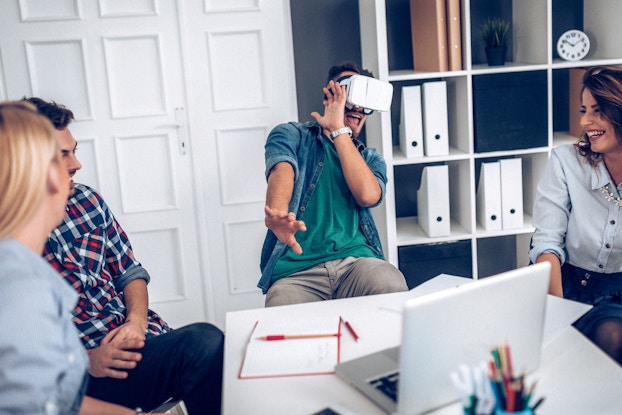
When the coronavirus pandemic caused concerts and events around the world to be cancelled or postponed, event producers quickly pivoted, seeking new solutions to keep fans and customers engaged. Musicians from Josh Groban to Macklemore performed via livestreaming to fans at home. E-commerce marketplace giant Alibaba announced a series of 20 virtual tradeshows to support buyers and sellers impacted by the coronavirus. Even intrinsically virtual industries, such as gaming, have had to modify their business models in the shadow of COVID-19.
Joseph Kale, owner of jdk>design inc., designs sets for live events for the gaming industry. He has created sets for such events as the League of Legends World Championships, Counter Strike World Championship, Capcom Cup and PlayStation console launches. “I needed to quickly pivot from designing large sets for a live audience sometimes numbering tens of thousands to a more intimate setting specifically designed for a streaming broadcast.”
Pivoting like this means businesses need new and more virtually interactive ways to communicate with customers. Fortunately, the technology already exists. We’re talking immersive technology such as augmented and virtual reality and you may be surprised to learn the technology can work for your small business, too. Here’s what you need to know.
Immersive technology explained
Even before COVID-19 changed the world’s way of conducting business, immersive technology was a key trend to watch for in 2020. While virtual reality (VR) and augmented reality (AR) experiences were previously associated with the gaming and entertainment industries, now consumer solutions are on the horizon.
The technology enables users to immerse themselves in a replication of the physical world and interact with objects and people within that virtual world. For marketers, the technology can help create innovative customer experiences designed to engage and connect. Both AR and VR may find a place in your small business marketing strategy.
Augmented reality (AR) makes marketing and sales interactive
AR has emerged as a marketing and sales tool because it enables brands to give customers unique experiences via their mobile devices. With 3.5 billion smartphone users in the world today, that’s a lot of potential customers to reach. You’re likely familiar with the technology, but haven’t considered using it for business marketing. Similar to Snapchat and Instagram filters, AR allows the user to place digital images over real-world images or video. Pokémon Go used AR for their interactive game where users walked around cities and neighborhoods hunting for digital characters hiding in real-world locations.
Poised to be a leading force in sales and marketing over the next decade, AR allows marketers to upgrade the experience offered to customers and therefore increase sales. Some examples include:
- Furniture businesses that use AR allows users to choose household accessories and virtually arrange them in their own homes.
- Companies selling eyeglasses or sunglasses use AR to allow customers to upload their own photos to “try on” the glasses virtually.
- Makeup and hair products can be applied virtually in the same manner.
- Likewise, clothing pieces can be tried on virtually by consumers uploading their pictures.
There are already many AR apps available to start boosting your marketing power. Snapchat has a production tool called Lens Studio which allows businesses to generate Face Lenses (front camera experiences) and World Lenses (rear camera experiences). Another popular tool is Augment. Augment allows marketers to turn 2D images into 3D so customers can visualize all kinds of goods and 3D-objects in AR through their smartphones and tablets at home or work.
AR also enables marketers to enhance business cards and brochures so customers can scan printed materials with their mobile devices to access more information.
To survive the pandemic, small businesses need to embrace tech solutions more than ever, including tech they’re not yet familiar with.
Virtual reality (VR) creates a tailored customer experience
Where AR adds to the customer’s reality, VR replaces their vision. A complete immersion technology, VR is a computer-generated simulation of real life. Users see and hear in the 3D virtual environment and can interact within the computer world. VR allows customers to simulate an experience in 360 degrees using a headset equipped with special lenses. (The number of VR headsets sold is predicted to reach 82 million in 2020, a 1,507% increase from 2017.)
With more capabilities than AR, VR allows marketers to create a personalized experience bringing tailored features and solutions to their customers. Customers can shop in a completely virtual store and designers, such as architects and construction companies, can immerse them into that environment before one nail is hammered. Similarly, travel and tourism businesses can show customers the kind of experience they’re signing up for without leaving their homes.
Socially responsible shoe manufacturer, Tom’s, whose “buy one, give one” mission statement got a boost by doing more than just telling their customers about their good deeds. Using VR, Tom’s founder took customers on a tour of Peru showing donors where their money goes and giving customers an intimate experience they want to keep contributing to by buying more shoes.
VR technology already exists for small business use. Google Cardboard, Samsung Gear VR / VR 2 and Facebook’s Oculus recently released portable versions to boost customer experiences anywhere, anytime.
The timing is right
To survive the pandemic, small businesses need to embrace tech solutions more than ever, including tech they’re not yet familiar with. Tradeshows, real estate, retail and beauty are just a few industries benefiting from VR and AR technologies.
And, luckily, consumers are in the right frame of mind to adopt new technologies. According to Nielsen, 2020’s consumers have greater motivations and fewer barriers to more actively seek technology-enabled solutions. Whether the behavior is new for some consumers or technology usage has increased for the skilled user, the post COVID consumer seems primed to seek out brands offering experiences sympathetic to their new way of living.
CO— aims to bring you inspiration from leading respected experts. However, before making any business decision, you should consult a professional who can advise you based on your individual situation.
Want to read more? Be sure to follow us on LinkedIn!
CO—is committed to helping you start, run and grow your small business. Learn more about the benefits of small business membership in the U.S. Chamber of Commerce, here.










